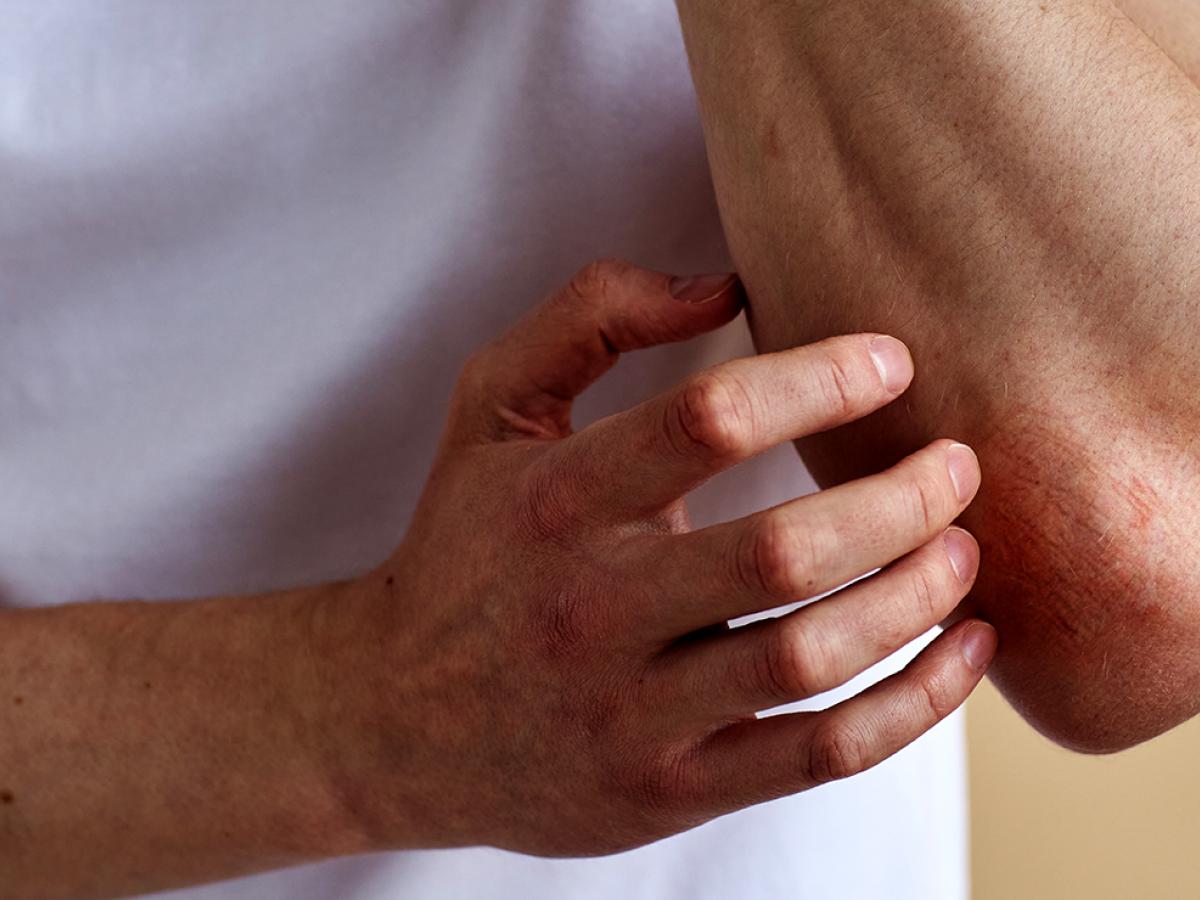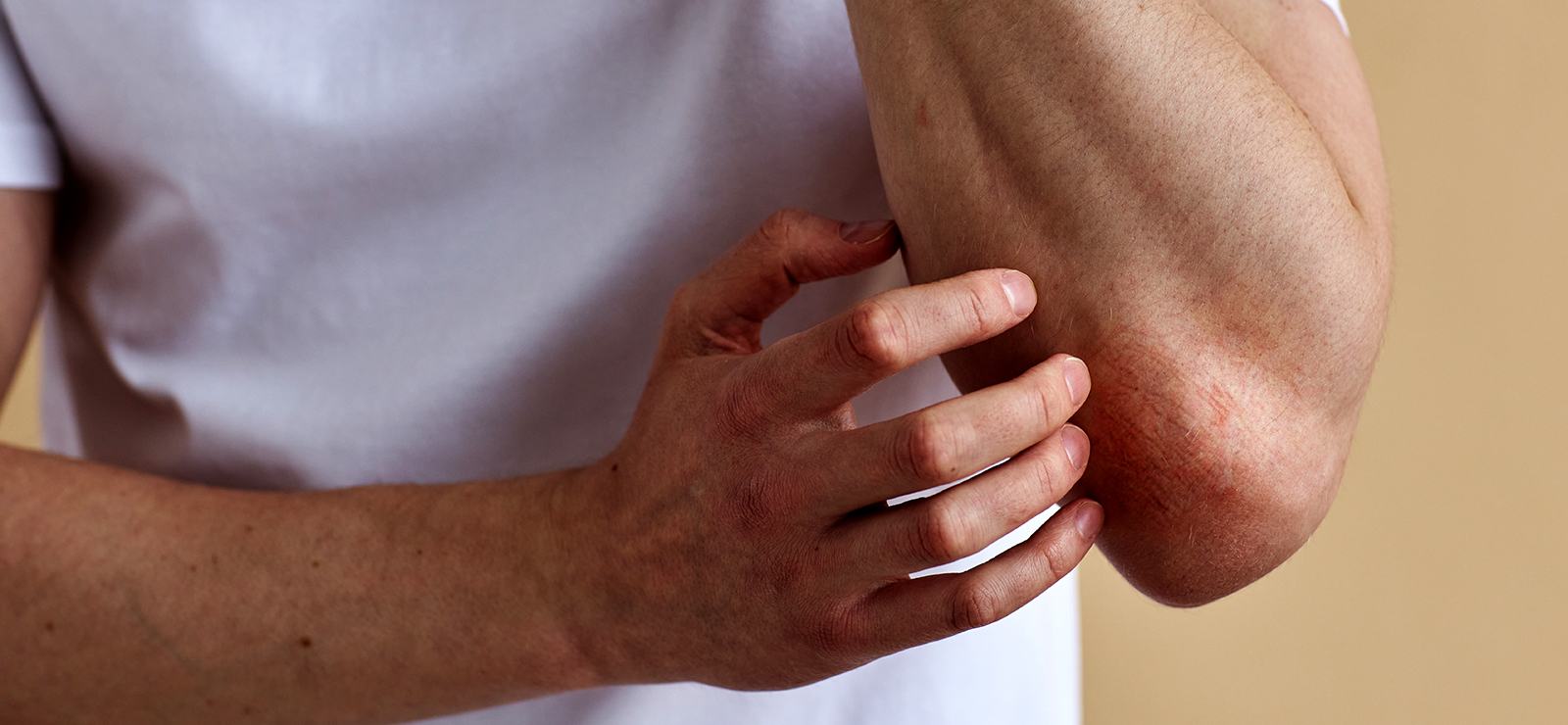July 23, 2025

Everyone gets dry skin from time to time. Maybe you forgot to moisturize, used a harsh soap or have been exposed to dry heat all winter. But if your dry skin has the appearance of thick, red, scaly patches and doesn’t go away with basic lotion, you could be dealing with psoriasis.
Psoriasis is a chronic disease that affects 3% of adults in the United States, or around 7.5 million people. Approximately 600,000 of those people are undiagnosed.

“You can develop psoriasis at any time in your life, from very early in childhood all the way until you are quite elderly,” says Kara LeFevre, MD, an MU Health Care dermatologist. “It’s incredibly individual in terms of severity, frequency and how much it bothers you. I see patients who have a lot of psoriasis, covering large areas of their body, and they are unbothered. Others have small but bothersome amounts in key or cosmetically sensitive places.”
The good news is that there is treatment for psoriasis, regardless of how much you have or how often you get it. Even if your psoriasis doesn’t bother you, knowing that you have it — and what to expect — is always a good idea.
Dr. LeFevre shares what everyone should know about this common skin disease:
What Is Psoriasis?
Psoriasis is an inflammatory skin condition caused by an abnormal immune response. An overactive immune system can lead to chronic inflammation that causes the skin to produce new cells too quickly. Those skin cells build up and form scaly plaques. People with psoriasis may also experience itching, thick nails or joint pain — all from inflammation.
Psoriasis is not contagious and can pop up anywhere on your body. It affects all skin types, skin tones, races and ethnicities. Psoriasis can run in families, but just because you have a family member with psoriasis does not mean you will develop it.
“You may have a genetic tendency for psoriasis,” Dr. LeFevre says. “But there are typically other factors or lifestyle choices that tip you into a disease state.” If you are predisposed to psoriasis, modifiers that increase inflammation — such as smoking, alcohol or having hepatitis C — increase your risk.
Other risk factors include being male (although psoriasis is also common in females) and having a disease or condition that tends to occur alongside psoriasis, such as psoriatic arthritis or inflammatory bowel disease.
Types of Psoriasis
There are five types of psoriasis:
- Plaque psoriasis is the most common and affects up to 90% of the people living with psoriasis.
- Inverse psoriasis affects up to 30% of people with psoriasis and occurs in deep skin folds.
- Guttate psoriasis occurs in 8% of people with psoriasis and is characterized by small, round red spots and are not as thick as plaques.
- Pustular psoriasis only affects 3% of people with psoriasis, is more common in skin of color and involves painful pus-filled bumps surrounded by inflamed (reddened) skin.
- Erythrodermic psoriasis affect 2% of people living with psoriasis, is more common in Asians and can discolor more than 75% of the body.
You can develop more than one type during your lifetime or even have two or more types at the same time.
Reasons Psoriasis Might Flare Up
Psoriasis is a waxing and waning disease, meaning it may come and go throughout your lifetime.
“You may not have any plaques for months or years and then experience a flare-up that lasts a long time,” Dr. LeFevre says. “Sometimes we can pinpoint things that cause those flare-ups and sometimes we cannot.”
Common causes of psoriasis flare-ups include:
- Certain illnesses, such as streptococcus (strep throat), which can trigger guttate psoriasis
- Certain medications, such as oral steroids, lithium, antimalarials and beta blockers
- Stress, which can affect cortisol levels and increase inflammation
How to Tell if It’s Psoriasis or Eczema
Skin care can be tricky — especially when you notice an ongoing issue. Eczema, also known as atopic dermatitis, is another chronic inflammatory skin condition that can leave your skin dry, red and itchy. One type in particular — nummular dermatitis — is easy to confuse with psoriasis. It tends to also have a round shape and can be thicker and plaque-like. However, Dr. LeFevre says there are a few factors that can help distinguish eczema from psoriasis.
Do you have:
- Allergic rhinitis (hay fever) and asthma? These two conditions often occur with eczema (called the atopic triad).
- Patches behind your knees and elbows? Eczema tends to show up in the hollow spaces behind knees and elbows, while psoriasis is more likely to appear on the outer, pointy areas of those body parts.
- Sensitive skin? People with eczema often have sensitive skin. If your skin isn’t known to be dry or sensitive to products such as soaps or laundry detergents, you are more likely to have psoriasis.
Dr. LeFevre cautions that self-diagnosis is never a good idea and may hinder you from getting the treatment you need for your skin condition. A dermatologist can typically diagnose psoriasis or eczema based on its visual characteristics and tendencies, alongside your family and personal health history.
Psoriasis Treatment
The good news? Psoriasis has been effectively treated for more than 50 years, though treatment options have improved and expanded in that time. Treatments are now more targeted, with fewer side effects and medication interactions. Treatment options include topicals (cream or ointment), oral medications and injectables.
“We have such good treatments now — some given once every month or couple of months,” Dr. LeFevre says. “Patients have the potential to be entirely clear of psoriasis. So, it’s possible to go from having 40% of your body covered with plaques to 3% or even none. It can be life changing.”
Dr. LeFevre says to think about psoriasis treatment as a ladder of therapeutics, with topical treatments at the bottom, then oral drugs, and finally, biologic therapy (injections) at the top. You don’t necessarily have to start at the bottom and work all the way up. When it’s warranted, you can skip a bunch of rungs and go straight to systemic treatments.
Determining the best treatment for your condition involves calculating the severity of your psoriasis. “The general rule of thumb is that the size of your palm is equal to 1% of your body surface area,” Dr. LeFevre explains. “To get an idea of the general body surface area affected, we roughly calculate how many ‘palms’ of psoriasis are covering your body.”
More than 10% (10 “palms”) coverage typically gets treated with systemic therapy instead of topical. Some specific scenarios, such as psoriasis affecting the nails or scalp, may warrant systemic therapy even if the psoriasis doesn’t cover 10% of the body.
“We tailor treatment not just to your body surface area, but also to the patient and how bothered they are,” Dr. LeFevre says. “Our goal, first and foremost, is to improve your quality of life.”
Next Steps and Useful Resources
- Want to discuss more with a dermatologist? Find one today.


